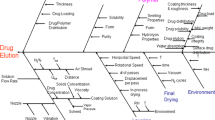Abstract
The ultrasonic spray technology is studied by the method of theoretical derivation, CFD simulation, spray particle diameter detection and analysis, and experimental analysis. And the ultrasonic spray process for the coating of vascular stent is also optimized. Firstly, the ultrasonic atomization physical model is established and the equation of atomization particle diameter is derived. Secondly, the ultrasonic atomization process is simulated by the CFD method, and shows three atomization patterns: incomplete atomization pattern, critical atomization pattern and jet atomization pattern. The critical amplitude and power equation for ultrasonic atomization is derived. Thirdly, experiment is conducted to study the influence of parameters including power, gas pressure, and surface tension. The results show that the spray is stable though few particles are likely to collide each other during spray moving, and the droplet diameter is about 10 μm. The Rosin-Rammler distribution equation for ultrasonic spray is created, and the uniform index number is between 7.11 and 11.48. The uniformity of spray particle diameter, the efficiency of adjustment and the energy consumption are better than traditional spray technology. Lastly, the ultrasonic spray process parameters for stent coating are optimized to eliminate the common defects and obtain fine coating.
Similar content being viewed by others
References
Kipshidze N N, Iversen P, Kim H S, et al. Advanced c-myc Antisense (AVI-4126) eluting phosphorylc-holine-coated stent implantation is associated with complete vascular healing and reduced neointimal formation in the porcine coronary restenosis model. Catheterization Cardio-vascular Interventions, 2004, 61: 518–527
Nakayama Y, Zhou Y M, Hatsue I U. Development of in vivo tissue-engineered autologous tissue-covered stents (biocovered stents). J Artif Organs, 2007, 10: 171–176
Song S J, Park Y J, Park J, et al. Preparation of a drug-eluting stent using a TiO2 film deposited by plasma enhanced chemical vapour deposition as a drug-combining matrix stent coating. J Mater Chem, 2010, 20: 4792–4801
Suk K T, Kim J W, Kim H S, et al. Human application of a metallic stent covered with a paclitaxel-incorporated membrane for malignant biliaryobstruction: Multicenter pilot study. Gastrointestinal Endoscopy, 2007, 66(4): 798–803
Pan C J, Tang J J, Weng Y J, et al. Preparation, characterization and anticoagulation of curcumin-eluting controlled biodegradable coating stents. J Controlled Release, 2006, 116: 42–49
Chen Q, Zielinski D, Chen J, et al. A validated, stability-indicating HPLC method for the determination of dexamethasone related substances on dexamethasone-coated drug-eluting stents. J Pharmaceutical Biomedical Anal, 2008, 48: 732–738
Ni Z H, Gu X Z, Wang Y X. Rapid prediction method for nonlinear expansion process of medical vascular stent. Sci China Tech Sci, 2009, 52(5): 1323–13300
Cho H H, Han D W, Matsumura K, et al. The behavior of vascular smooth muscle cells and platelets onto epigallocatechin gallatereleasing poly(L-lactide-co-e-caprolactone) as stent-coating materials. Biomaterials, 2008, 29: 884–893
Huang Y, Venkatraman S S, Boey F Y, et al. In vitro and in vivo performance of a dual drug-eluting stent (DDES). Biomaterials, 2010, 31: 4382–4391
Suzuki K, Kirpalani M D, McCracken W T. Experimental investigation of ethanol enrichment behavior in batch and continuous feed ultrasonic atomization systems. Chem Eng Technol, 2006, 29(1): 44–49
Xu Z J, Chu R Q, Li G R, et al. Preparation of PZT powders and ceramics via a hybrid method of solgel and ultrasonic atomization. Mater Sci Eng, 2005, 117(B): 113–118
Steirer K X, Reese M O, Rupert B L, et al. Ultrasonic spray deposition for production of organic solar cells. Sol Energy Mater Sol Cells, 2009, 93: 447–453
Sindayihebura D, Dobre M, Bolle L. Experimental study of thin liquid film ultrasonic atomization. ILASS-Europe’99, Toulouse: [s. n.], 1999: 1–5
Edwards W S, Fauve S. Patterns and quasi-patterns in the Faraday experiment. Fluid Mech, 1994, 278: 123–148
Lang R J. Ultrasonic atomization of liquids. Acoust Soc Am, 1962, 34: 6–9
Rayleigh. Theory of Sound. England: Dover Press, 1946
Dobre M, Bolle L. Visualization and analysis of liquid film surface patterns formed on ultrasonic atomizers. ILASS-Europe’99. Toulouse: [s. n.], 1999
Lacas F, Versaevel P, Scouflaire P, et al. Design and performance of an ultrasonic atomization system for experimental combustion applications. Part Part Syst Charact, 1994, 11: 166–171
Barrears F, Amaveda H, Lozano A. Transient high-frequency ultrasonic water atomization. Exp Fluids, 2002, 33: 405–413
Tsai S C, Childs P, Luu P. Ultrasound-modulated two-fluid atomization of a water jet. AIChE J, 1996, 42(12): 3340–3350
Miesse C C. Correlation of experimental data on the disintegration of liquid Jets. Ind Eng Chem, 1955, 47(9): 1690–1701
Rosin P, Rammler E. The laws governing the fineness of powdered coal. J Inst Fuel, 1933, 7: 29–36
Author information
Authors and Affiliations
Corresponding author
Rights and permissions
About this article
Cite this article
Yi, H., Huang, J., Gu, X. et al. Study on ultrasonic spray technology for the coating of vascular stent. Sci. China Technol. Sci. 54, 3358–3370 (2011). https://doi.org/10.1007/s11431-011-4580-0
Received:
Accepted:
Published:
Issue Date:
DOI: https://doi.org/10.1007/s11431-011-4580-0




